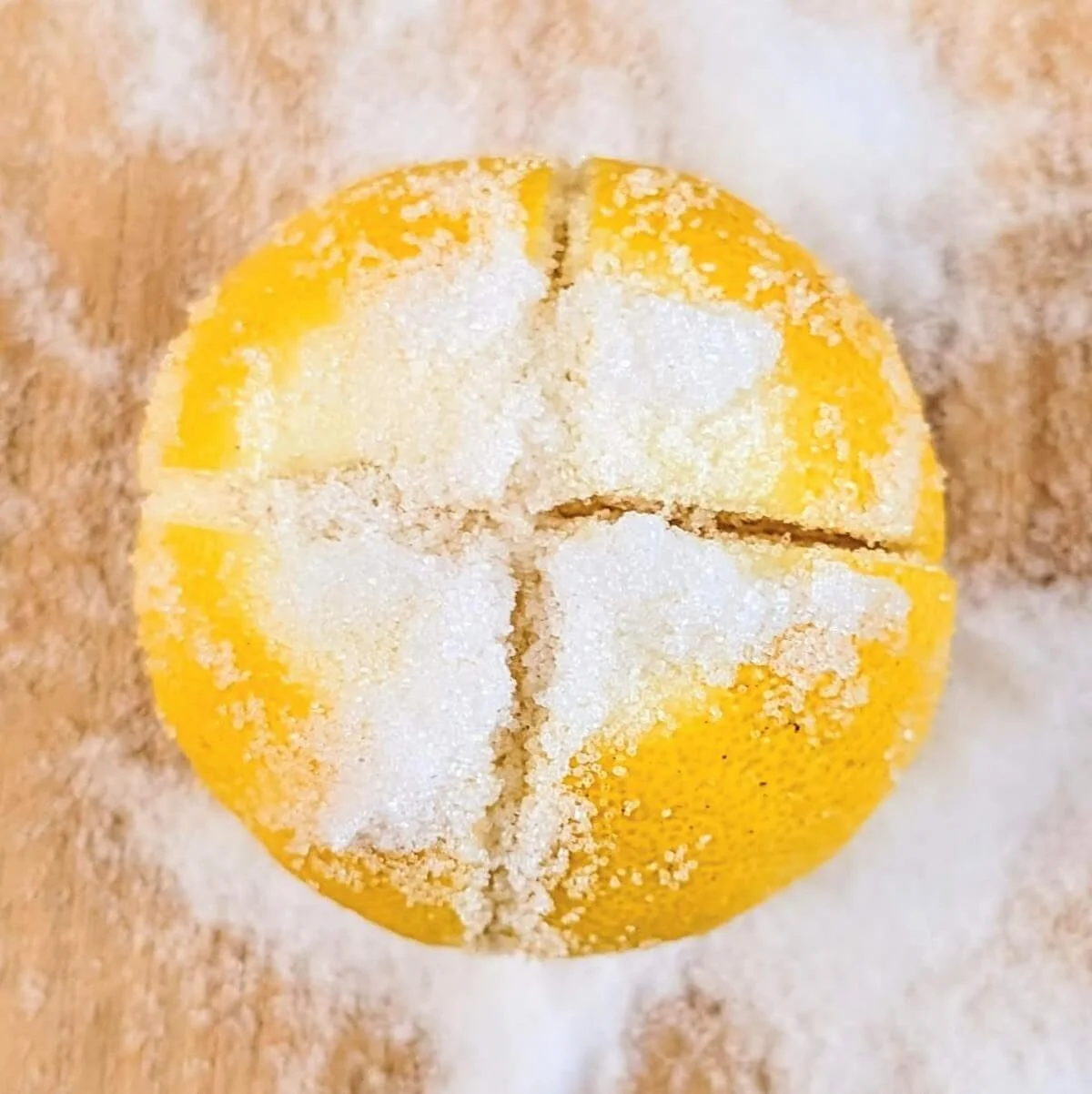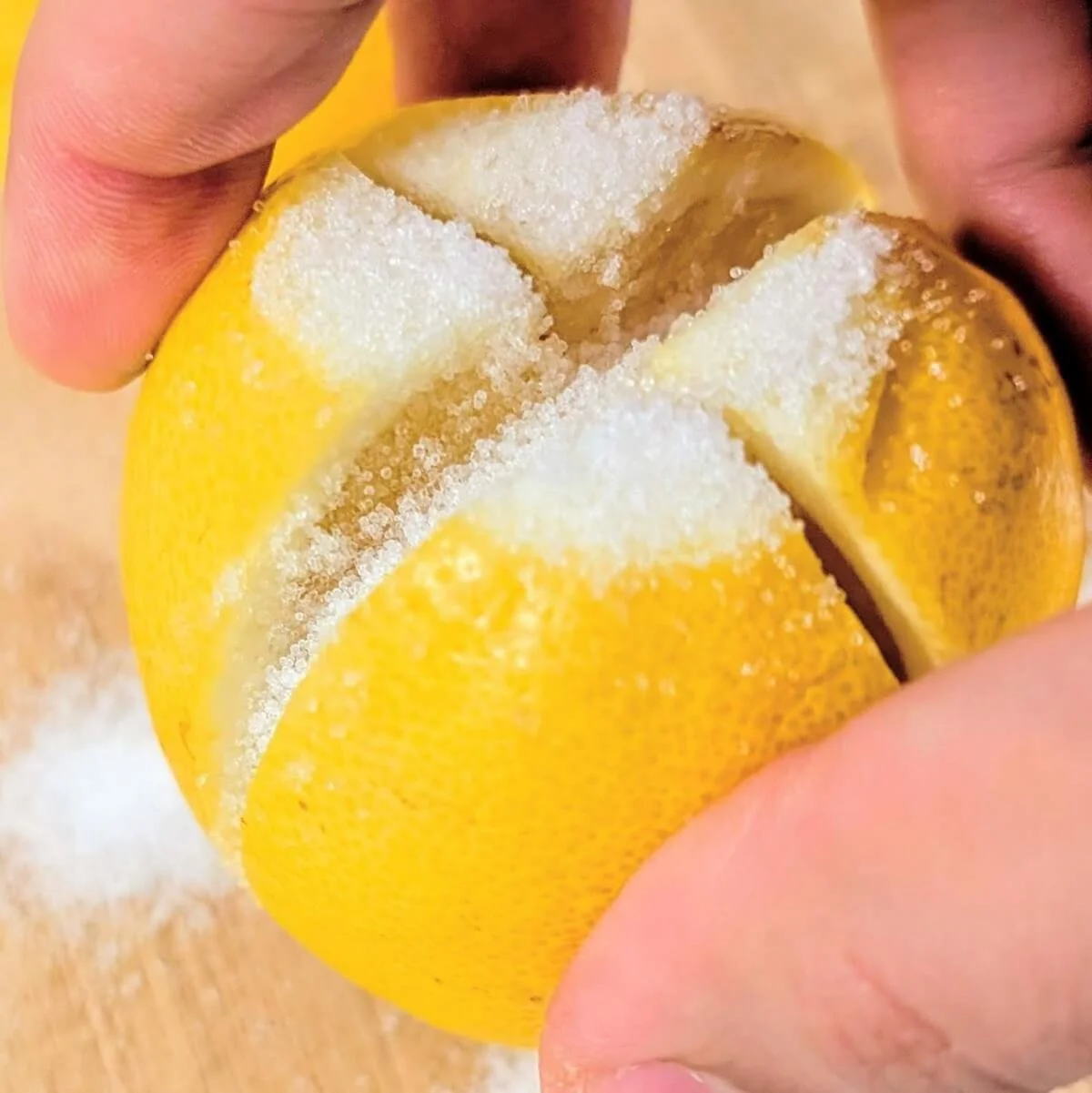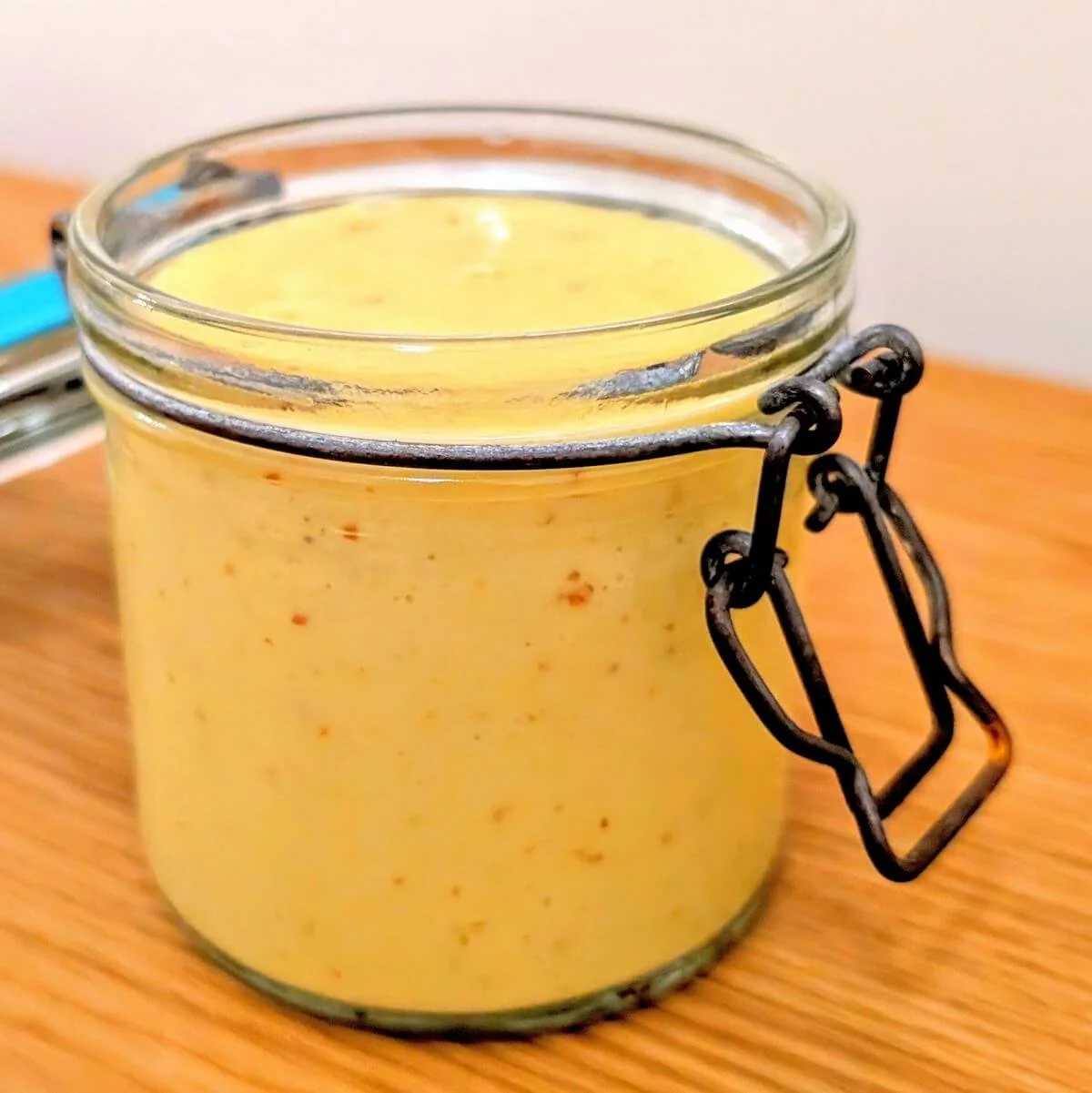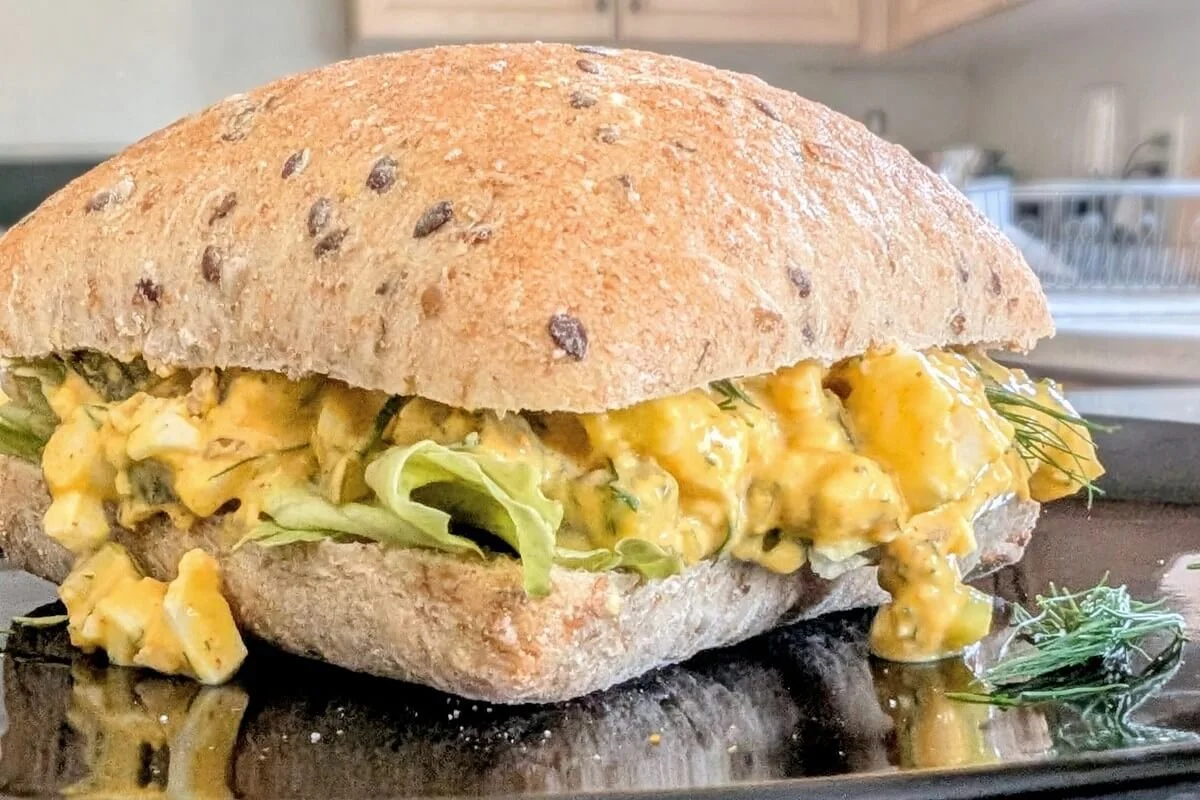How to Make and Use Preserved Lemons (Bag Method)
Make preserved lemons like a pro cook with this simple restaurant kitchen hack—an easy step-by-step guide, plus delicious ideas to use the rind, pulp, and brine.
What are Preserved Lemons and What Makes These so Special?
Preserved lemons are simply lemons cured in salt. A bit of time and a handful of salt transform ordinary lemons into something complex, fragrant, and deeply savory. The harsh bite mellows, the rind softens, and the flavor concentrates into a salty-citrus burst unlike anything a fresh lemon can give you.
In Morocco, where preserved lemons originated, whole lemons are packed with salt in jars and left to cure at room temperature for weeks. They’re a classic in tagines and stews, but today cooks sneak them into just about anything—from salads and pastas to cocktails and even desserts.
In restaurant kitchens, lemons are preserved in vacuum bags for ease and consistency. This fridge-based method keeps them submerged, cures them evenly, and avoids common jar issues like mold or gas buildup. It’s the approach I brought home from my years in professional kitchens—working just as well with a simple zip-top bag to deliver restaurant-quality results at home.
Why You’ll Love This Preserved Lemon Recipe
Made in a bag, not a jar: With a vacuum-sealed or zip-top bag and a quick massage, there’s enough liquid for the lemons to stay submerged as they cure—no need to top up with extra lemon juice.
Fridge-cured for peace of mind: Salted lemons cure slowly and safely in the fridge, with no room-temp risks like mold, gas buildup, or corroded jar lids—making it the best way to preserve lemons at home.
Perfect for small batches: Since you don’t need to fill a whole jar, you can preserve just one or two lemons at a time.
What’s Ahead in This Preserved Lemon Guide
Best ingredients and swaps: Discover which lemons are best for preserving, the right salts to use, and flavor variations to make your preserved lemons your own.
How to use preserved lemons: A clear breakdown of how to use the whole lemon: rind, pulp, and brine (yes you should use it all!)—plus how to turn them into a paste for easy everyday seasoning.
Common uses and serving ideas: From classics like chicken tagine and couscous to modern twists like vinaigrettes, dips, compound butters, and even cocktails.
Pro tips: My kitchen-tested tricks to guarantee perfect results every time.
Storage: Exactly how to keep your preserved lemons fresh for months (or even up to a year) in the fridge, plus freezer tips.
FAQs: Answers to common questions—like how to know when your lemons are ready, how to spot spoilage, and whether you really need to follow all those traditional rules you see online.
But first, I’ll walk you through this simple preserved lemon recipe step-by-step, so you can get a batch curing in your fridge today.
Let’s get preserving!
What You’ll Need for Homemade Preserved Lemons
Preserved Lemon Ingredients
4 whole lemons, washed thoroughly
4 heaping tablespoons pickling salt
Equipment Needed to Preserve Lemons at Home
Knife and cutting board
Tablespoon
Vacuum bag or zip-top bag
Makes: 4 preserved lemons
Prep: 5 min Cure: 4 weeks
How to Make Preserved Lemons
Step-by-Step with Photos
Step 1: Prep the lemons for preserving
Cut a thin slice off both ends of each lemon. Then stand each lemon on one end and slice lengthwise down the middle, stopping just before the base so it stays attached. Turn and slice again to make quarters, keeping the bottom intact. This way, the lemons open like a flower—perfect for packing with salt.
Step 2: Pack the lemons with salt
Place one lemon on your cutting board or in a bowl to catch stray salt. Pack a heaping tablespoon of pickling salt into the center. Press any salt that spills out back inside, then close the lemon and transfer it to your vacuum or zip-top bag. Repeat with the rest, then sprinkle any leftover salt from your work surface into the bag too.
Step 3: Seal the salted lemons in the bag
Vacuum-seal the lemons, or if you’re using a zip-top bag, press out as much air as possible before closing.
Once sealed, gently squish the lemons with the palm of your hand until they release their juices. The lemons should look slightly flattened, sitting in their own brine.
Step 4: Cure the salted lemons in the fridge
Place the sealed bag of salted lemons in the fridge, flipping it about once a week so they cure evenly. Leave them to cure for at least 4 weeks.
By then, the rind should be soft and the sharp acidity mellowed. If the rind still feels a little firm, don’t worry—preserved lemons only improve with time, continuing to soften and develop deeper flavor as they age. If you can stand to wait, let them cure for a few months for the best flavor.
What’s the Best Salt for Preserved Lemons?
The best salt for preserving lemons is pickling salt or kosher salt. Both dissolve well, pack easily into the lemons, and give the cleanest flavor. Other salts work too, but each comes with a few quirks. Here’s a quick guide:
Pickling salt: Fine-grained and pure, with no additives. It dissolves quickly and evenly, which makes it my top choice and what I used for this batch.
Kosher salt: A chef’s favorite in restaurant kitchens. The large, flaky crystals are easy to pack, and the flavor is clean and balanced.
Sea salt: Works well if it’s a fine or medium grind. Avoid coarse flakes (like Maldon), which don’t pack or dissolve as well inside the lemons.
Table salt: Works in a pinch. Iodized table salt is often discouraged, but it won’t ruin your preserved lemons. Some people notice a faint metallic taste in acidic recipes, but if that doesn’t bother you, go ahead and use it. I cover more of the details and research in the FAQs below.
Himalayan pink salt: Fine-grain works, but it may tint the lemons and brine a pinkish-orange color over time. Harmless, but not ideal if you want your preserved lemons to stay bright yellow.
Low-sodium salt: Avoid this one. Without enough salinity, the lemons won’t cure properly.
What Are the Best Lemons for Preserved Lemons?
The best lemons for preserving are small, thin-skinned varieties like Meyer lemons. Their soft rinds cure more quickly and evenly, giving a tender texture and balanced flavor. Other types work too, but some need more time or care. Here’s a quick guide:
Meyer lemons: Thin-skinned, slightly sweeter, and very aromatic. They cure quickly and become especially soft and fragrant—ideal if you can find them.
Eureka or Lisbon lemons: The most common supermarket varieties. Thicker skins mean they take a little longer to soften, but they’re still excellent for preserving. When shopping, choose smaller lemons with thinner skins if you can.
Organic lemons: Best when possible, since you’ll be eating the peel. They may still have a natural wax coating (like beeswax), so give them a good scrub. Conventional lemons are coated with synthetic waxes and pesticides, so if that’s what you’re using, scrub well—or even give them a quick blanch in hot water—before preserving.
Large, pithy lemons: Best to avoid. Their thick, spongy skins may never fully soften, and they’re less juicy with a more bitter flavor.
Preserved Lemon Flavor Variations
Toss any of these into the bag with your salted lemons before sealing—mix, match, and have fun!
Warm spices: Add a cinnamon stick, peppercorns, cloves, or allspice for a cozy spice note.
Herbal twist: Slip in a sprig of rosemary, thyme, or a bay leaf for an earthy depth.
Heat boost: Scatter 1 tsp red chili flakes or a few thin slices of fresh chile for a spicy kick.
Savory zing: Include 2–3 smashed garlic cloves or ginger slices for extra savory layers.
Citrus swap: Substitute limes, mandarins, grapefruit, or oranges (same salt method) for a citrusy twist.
How to Use the Different Parts of a Preserved Lemon
Now that your preserved lemons are fully cured, here’s how to prepare each component so it’s ready for any recipe. There’s no need to rinse—simply use the natural saltiness to season your dishes, and reduce any additional salt accordingly.
How to use preserved lemon rind: Scoop out the pulp, then slice the softened rind into thin strips or dice into small pieces. Add them into dishes that benefit from a bit of texture—think salads, salsas, or guacamole.
How to use preserved lemon pulp: Discard the seeds and roughly chop the pulp. Fold or blend it into dressings, dips, or soups where it can add deep layers of flavor without impacting texture.
How to use preserved lemon brine: If you’ve added whole spices, strain them out first. Then use the brine like you would miso paste or Worcestershire—just a teaspoon at a time to season marinades, vinaigrettes, or sauces with salty, tangy depth.
How to make a preserved lemons paste: Deseed and roughly chop both rind and pulp, then pulse in a food processor or blender with a splash of brine to create a smooth, spreadable paste. Keep it on hand to season whole roast chicken, stir into compound butters, or anywhere you need a concentrated lemon boost.
Preserved lemon pulp—chopped and ready to use.
What to Do With Preserved Lemons: Common Uses and Serving Ideas
Classic Moroccan Preserved Lemon Uses
Tagines: The signature use: lamb, fish, or chicken tagine is studded with preserved lemon rind and green olives, and slow-braised with spices like saffron, ginger, and cinnamon.
Soups and stews: A few chopped pieces of preserved lemon rind are often stirred in at the end to brighten bean- and tomato-based Moroccan soups.
Couscous seasoning: Finely chopped rind is commonly added to steamed couscous along with olive oil, onions, and cilantro, adding a bright, citrusy note.
Chermoula: This classic herb-and-spice paste often includes preserved lemon pulp and brine—along with cilantro, parsley, garlic, cumin, and paprika—to marinate fish, seafood, or grilled meats.
Modern Preserved Lemon Recipe Ideas
Sauces: Blend chopped pulp, a splash of brine, olive oil, lemon juice, maple syrup, and Dijon mustard to create a zippy preserved lemon dressing. Or try adding it to my tahini sauce, Caesar salad dressing, or blender hollandaise sauce for a citrus boost.
Dips: Stir minced rind and pulp into white bean dip, guacamole, or hummus to give them a refreshing lemony twist.
Salsas: Fold diced preserved lemon into jajik (cucumber-yogurt sauce), pico de gallo, zhoug cilantro sauce, or salsa verde for extra texture and zesty flavor.
Salads: Toss some of the chopped rind into an egg salad, kale power salad, Arabic chopped salad, or herby tabbouleh to brighten things up.
Topping for fish: Scatter thin strips of rind, fresh herbs, and garlic over salmon, cod, or other fillets before roasting for an elegant finish.
Vegetables: Drizzle a little preserved lemon brine over marinated green beans, roasted Mediterranean veggies, or sautéed Brussels sprouts for an easy, tangy lift.
Pasta: Stir minced preserved lemon into a chicken pesto pasta to amplify the fresh pesto flavor.
Compound butter: Combine finely diced rind and pulp with softened butter, roasted garlic, fresh herbs, and a touch of grainy mustard. Spread on a warm baguette or melt over grilled steaks.
Cocktails & drinks: Muddle chopped pulp in margaritas, mezcalitas, or Bloody Marys—or add a teaspoon of brine to sparkling water for a bright, effervescent refresher.
Desserts: Swirl preserved lemon paste into lemon curd, whipped cream, cheesecake batter, or caramel sauce to add a sweet-salty element.
I may earn a small commission from some of the links on this page if you make a purchase, at no extra cost to you. I only recommend products I genuinely believe in and already have or would purchase myself.
My Tips for the Best Preserved Lemons
Use organic lemons if possible: Since you’re eating the rind, organic fruit gives you a cleaner flavor and peace of mind—no need to worry about artificial waxes or pesticide residues.
Wash the lemons well: Even organic lemons benefit from a good scrub under running water with a stiff brush to remove any dirt or coatings. For conventional fruit, consider a quick blanch in boiling water to strip off additional wax.
Choose thin-skinned lemons: Meyer, small Eureka, or Lisbon lemons cure faster and produce more tender, less-bitter peels—ideal if you can find them.
Give them a good squish: After sealing in the bag, gently press each lemon to release its juices. This jump-starts the brine and speeds up rind softening.
Don’t stress precise salt measurements: Preserved lemons are meant to cure in plenty of salt. Whether you use kosher, pickling, sea salt, or even table salt, a heaping tablespoon per lemon gives reliable results—no kitchen scale required.
Invest in a vacuum sealer: While a simple zip-top bag works perfectly for this recipe, a vacuum sealer is quite the next-level upgrade.
I use this exact Cuisinart vacuum sealer all the time—not just for preserved lemons, but for sealing meats before camping trips, freezing leftovers, and prepping make-ahead recipes. It keeps food fresher, reduces waste, and makes food prep a breeze!
How to Store Preserved Lemons and How Long They’ll Last
Fridge: Keep whole lemons (and their brine) sealed in their bag or transfer everything to a clean storage container or jar, making sure the lemons stay fully submerged. Properly stored, preserved lemons will keep bright and flavorful for up to a year (and often much longer) in the refrigerator. See FAQs on how to know if they’ve gone bad.
Freezer: Although preserved lemons keep almost indefinitely in the fridge thanks to their high salt and acidity, you can freeze them if you ever run low on brine or just want pre-portioned convenience. Pack chopped rind, pulp, or paste into ice-cube trays or small freezer bags, then freeze for up to 6 months—perfect for quick seasoning without worrying about keeping them submerged.
Use clean utensils not hands: Always fish out lemons, scoop pulp, or pour brine using a clean spoon or fork. This prevents contamination and keeps your preserved lemons lasting longer and tasting their best.
Preserved Lemon FAQs
What do preserved lemons taste like?
Preserved lemons taste bright, salty, and intensely lemony, with an umami punch that fresh lemons don’t have. The salt softens the sharp acidity and brings out a rich, savory-citrus flavor that’s perfect for adding depth to tagines, salads, and sauces.
How can I tell when preserved lemons are ready?
You’ll know preserved lemons are ready when the rind feels soft and gives easily under gentle pressure. They should taste tangy, salty, and mellow—without any sharp bitterness. This usually takes at least four weeks in the fridge. For a final check, slice off a bit of rind, taste it, and if it’s tender and flavorful, your lemons are done.
Can preserved lemons go bad?
Although rare, yes, preserved lemons can go bad. They keep for up to a year or more if properly stored in the fridge, but always check your lemons before using. If you spot any fuzzy spots or discoloration on the rind, or if the brine smells sour or rotten instead of fresh and lemony, it’s time to discard the batch.
Do I need to rinse preserved lemons before using?
You do not need to rinse preserved lemons before using them. Their built-in saltiness and citrus flavor are meant to season your dishes, so simply dial back any added salt. If you’re working with an especially salty recipe, a quick rinse can mellow them, but most of the time, you can use them straight away.
Should I use the whole preserved lemon or just the rind?
You can use the whole preserved lemon: rind, pulp, and brine (just remove any seeds first). Each brings something different to the table:
Rind: Gives a bright, salty-citrus pop in salads, salsas, or grain bowls.
Pulp: Adds juicy, tangy-umami flavor when folded or blended into dressings, dips, or soups.
Brine: A powerful seasoning—use sparingly, a teaspoon at a time, in marinades, vinaigrettes, or sauces.
Are preserved lemons fermented or just cured?
Preserved lemons are almost always salt-cured, not fully fermented. Traditional Moroccan methods and my fridge-based bag technique both use a high salt concentration (about 10–15% by weight), which inhibits bacterial growth.
The lemons then soften and mellow through osmosis and their own enzymes rather than fermentation. You’d have to lower the salt to around 2–3% to invite true lacto-fermentation—resulting in a tangier, more “pickle-y” flavor profile.
Can preserved lemons be frozen?
Yes, you can freeze preserved lemons for up to six months. Pack chopped rind, pulp, or paste into ice-cube trays or small freezer bags—then pop out cubes as needed for quick seasoning when needed.
Can I preserve lemons at room temperature?
No—this bag method isn’t suited for room-temperature curing; plastic bags can leak or burst from gas buildup. Always refrigerate for safety and consistency. If you prefer a warm cure, use the traditional jar method.
What’s a good substitute for preserved lemons in recipes?
A good substitute for preserved lemons in recipes is a quick paste made from equal parts fresh lemon zest, lemon juice, and an umami booster like miso paste, tamari (or soy sauce), or even MSG. While it won’t perfectly replicate the soft rind and mellow tang of preserved lemons, this blend delivers bright citrus, salty depth, and savory complexity in a pinch.
Can I use iodized salt for preserved lemons?
Yes, you can use iodized salt for preserved lemons.
Although many recipes say to avoid it, research on sauerkraut fermentation shows that iodine itself doesn’t hinder the curing process. Any past concerns usually stem from anticaking agents in table salt causing cloudiness in pickle brines or, in rare cases, a faint metallic taste.
Since preserved lemons rely on a high-salt cure with very little brine and have an intensely lemony flavor, feel free to use whatever salt you have on hand. If you’re extra sensitive to metallic tastes, kosher salt or pickling salt still offers the cleanest-tasting, most reliable results.
That’s it—enjoy your tangy homemade preserved lemons!
These preserved lemons are pure magic—bursting with tangy, complex, umami-rich flavor. They’ll brighten everything from grilled branzino and chicken tagine to salad dressings and even sweet treats like salted-caramel cheesecake.
Thanks to the simple bag-and-fridge method, you’ll have restaurant-worthy homemade preserved lemons without a jar. Just pack your lemons with salt, seal the bag, and let time work its wonder. The only hard part is waiting four weeks before you dive in!
Pin This Preserved Lemon Guide for Later!
Did you try this preserved lemon recipe?
I’d love to hear how your batch turned out—or what creative twists you added to make it your own. Drop a comment below or tag me on Instagram @onecreativecook if you share your creation!
More Pro Chef Techniques for Home Cooks
Perfect the five French mother sauces: Unlock the foundation of classic French cuisine with step-by-step recipes and serving ideas for each of the five essential sauces.
Make homemade broth from kitchen scraps: Discover how to transform vegetable peels, rotisserie chicken bones, and even herb stems into a flavorful, zero-waste broth.
Learn to make and use brown butter: Follow this simple guide to make nutty, golden brown butter and explore ideas for using it—from sauces and baking to finishing pastas.
Easily carve a roast chicken with scissors: Use just scissors and a few simple tips to carve your whole roast chicken perfectly and effortlessly.
Master campfire cooking: Learn how to build, maintain, and cook over an open fire with ease in this comprehensive guide.





















































